If you’ve never had fresh, made from scratch crackers, you’re missing out on one of life’s simple joys.
I used to make homemade crackers all the time. They’re easy, and they don’t take much time. I think I stopped because I made bread all the time, too, and we didn’t need both around to snack on. But when I’m out of both and feeling queasy, crackers are the answer.
Remember that I live way down a narrow road, deep in the boonies. I can mix up and bake a batch of crackers in half the time it takes me to drive to the store and back. Plus I won’t have to spend too much cash on an overpriced box of mediocre crackers with unpronounceable preservatives on the ingredient list, and I won’t have to spend another $3 in gas for the truck to get there. That makes homemade crackers even more of a bargain.
I used to carry the recipe around in my head, but it had been a while, so I had to look it up. I found the recipe and remembered most of what I did differently. And as I worked, the rest of what I used to differently came back to me.
The ingredients:
1 cup unbleached flour, 1 cup whole wheat flour, 1 tsp. salt, 3/4 tsp. baking soda, 4 tablespooons butter, 1 cup buttermilk. Preheat the oven at 375 degrees fahrenheit, and have a greased cookie sheet or two ready.

Use a medium-sized mixing bowl. Add all the flour, baking soda, and 1 teaspoon salt. Mix well with a fork.

Cut the butter into chunks and add to the flour mixture.
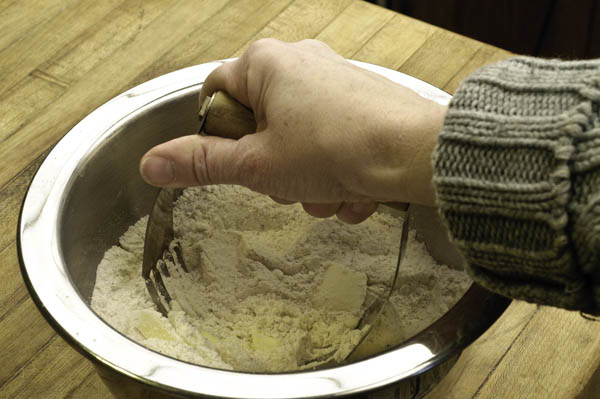
Use a pastry blender to cut in the butter. If you don’t have a pastry blender, you can use two table knives or even a fork. The pastry blender’s quicker, but you can get the job done without it.

Keep going until the butter & flour mixture resembles rough crumbs. Stir the mixture a little, just to make sure there’s not a sneaky chunk of butter hiding down there somewhere. I found one in the bowl pictured above. It only took a few more strokes with the pastry cutter to subdue that bad boy.

Add the buttermilk.

Mix gently with a fork until the liquid is absorbed, and the dough sticks together.
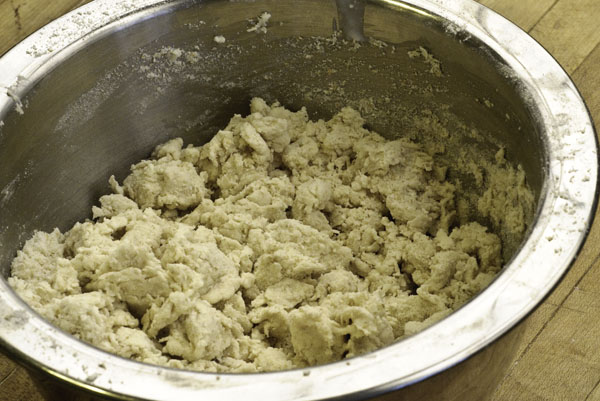
The mixture should look something like this. If you have obviously wet spots and extra flour, keep stirring. If you have a layer of extra flour at the bottom, you can sprinkle in a tiny bit of buttermilk over the dry stuff, then stir some more. Caution: if you must add extra liquid, do so in very small increments. Too much liquid creates a sticky dough, and that’ll give you all sorts of problems when you roll it out.
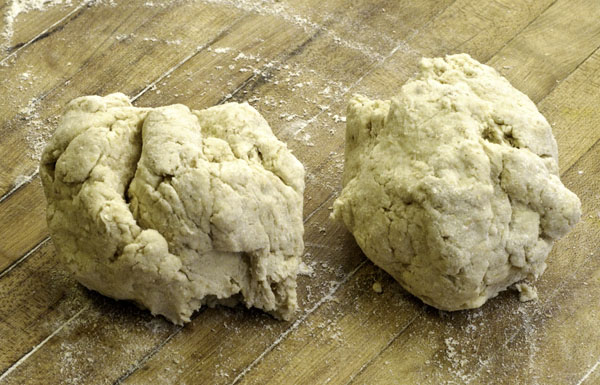
Now stick your hands down in that bowl and quickly shape the dough into a ball, then divide it in two.

Lightly knead each of the smaller dough balls to smooth the texture. Do it quickly, and don’t overwork it. You don’t want the heat from your hands to melt the butter in the dough mixture. That’ll make the crackers tough instead of crispy.
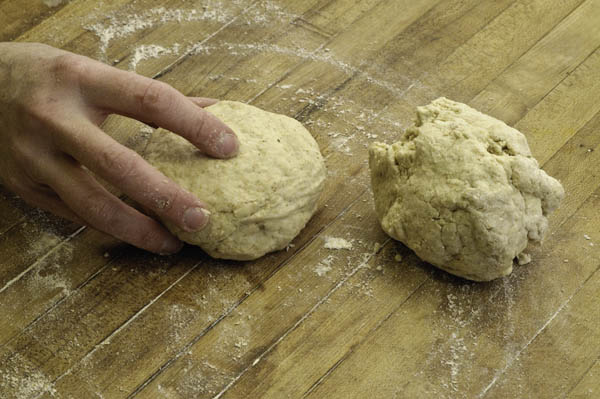
The dough ball on the left is smooth enough.
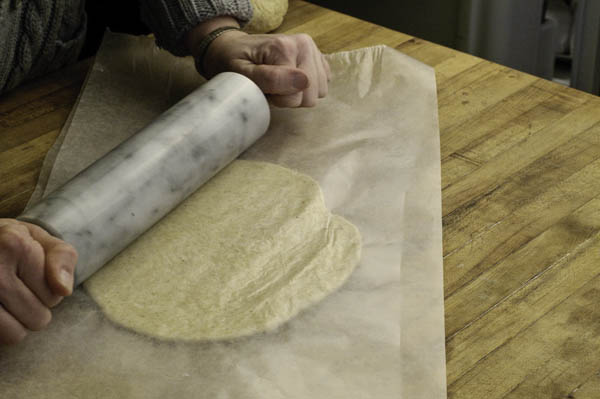
Most cracker recipes suggest rolling out the dough between two sheets of plastic wrap or waxed paper. I hate using plastic wrap for this for two reasons. 1) It seems to me like a wasteful use of plastic. 2) The plastic wrap is a lot of trouble to work with, always sticking to what it shouldn’t and not sticking when it should. Maybe that’s just a personal conflict between me and the plastic. You go ahead and use it if you want. I’d rather use waxed paper — or nothing at all.
This time, I used waxed paper on the first dough ball. As I rolled and turned and rolled and turned, I remembered why I stopped using the waxed paper to roll out crackers.

The good part is there’s no big flour mess to clean off the countertop. But the waxed paper tends to wrinkle up, and the dough sticks to the paper. As I recall, I had less of a problem with this particular issue the one time I used plastic wrap. (But then there was that whole battle over the plastic wrapping up on itself.)

I had a little too much moisture in the dough, so it did stick some to the waxed paper. It’s usually easy to deal with. Just pull the paper back slowly, a little from this angle, a little from that.

Take your time.

If you don’t get it too much of a hurry, the paper will come off cleanly. You only need to remove the top sheet.
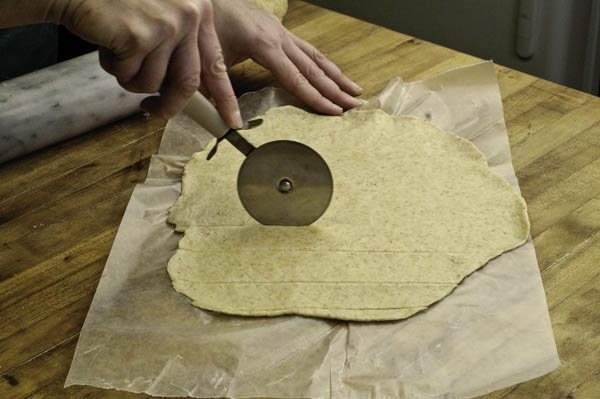
Use a pizza cutter or a knife to cut the dough into strips about 1 1/4 to 1 1/2 inches wide.

Cut across the strips to make squares.

Then peel up the squares and place on a greased cookie sheet. You can roll up the odd cuts and edge bits into a little dough ball, then roll it out to cut into squares, if you really want to. Or you could just stick the bits on the cookie sheet and bake them as they are. I’m lazy. I bake them as they are, call them test pieces, and eat them first.
(Note: The dough squares in the picture above are a little too thick. I tend to have that problem when I roll out the dough between waxed paper sheets. For the second ball of dough, I sprinkled flour on the counter and rolled the dough directly on the counter. To keep the dough from sticking, I turned the dough over frequently and sprinkled a thin layer of flour on the counter at each turn. I got much thinner crackers using this method and had a lot less trouble with sticking.)

Optional: sprinkle a little salt over the top of the cracker dough squares once they’re on the cookie sheet.

Use a fork to poke holes in the dough squares. Then bake at 375 degrees F for 10 to 12 minutes.

The finished crackers should be dry and slightly browned. They’ll harden as they cool. You can cool them on racks, on sheets of brown paper, or just leave them on the cookie sheet if you have a safe place to put them where they’re not likely to be bumped. Trust me, all it takes is one little bump of the pan for ten of those crackers to go flying off. The dogs get happy when that happens because they like cleaning up the tasty bits off the floor.
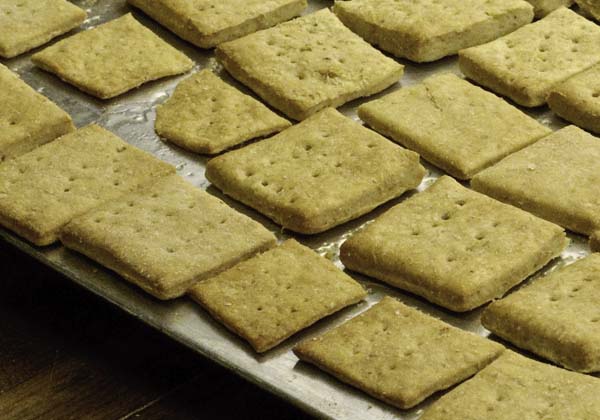
See how much difference there is between the thick crackers I rolled out using waxed paper and the thin ones I made later? The thinner crackers crisp up nicely. The thick ones, not so much. The thick ones are still edible, and they definitely did the job of keeping my queasy stomach settled when I didn’t feel so well. They just weren’t as tasty, and they didn’t have that delightful crisp texture that makes a cracker a cracker and not . . . say . . . a dog biscuit.
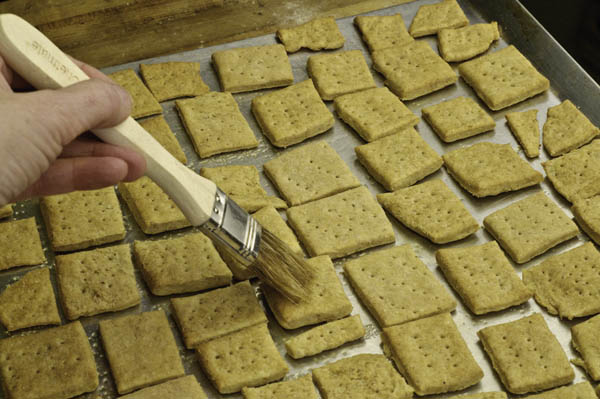
One last thing – lightly brush some hot, melted butter over the crackers when they come out of the oven. If you’re worried about the calories, do it anyway and go for a walk to burn off the extras. You’ll be glad you did.

When cool, toss the crackers into a bowl. Leave them nearby for handy snacking. They’ll be gone by the end of the day. Or sooner. Much sooner. Especially if you put a bowl of dip close by.



Oh Laura, thanks for this! One of my resolutions this year is to cut way down on processed foods, but I love crackers. Now I don’t have to give them up!